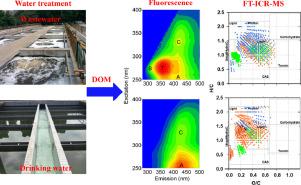Water Research ( IF 11.4 ) Pub Date : 2020-09-09 , DOI: 10.1016/j.watres.2020.116406 Weixin Shi , Wan-E Zhuang , Jin Hur , Liyang Yang

|
Dissolved organic matter (DOM) plays a critical role in determining the quality of wastewater and the safety of drinking water. This is the first review to compare two types of popular DOM monitoring techniques, including absorption spectroscopy and fluorescence excitation-emission matrices (EEMs) coupled with parallel factor analysis (PARAFAC) vs. Fourier transform ion cyclotron resonance mass spectrometry (FT-ICR-MS), for the applications in wastewater and drinking water treatments. The optical techniques provide a series of indices for tracking the quantity and quality of chromophoric and fluorescent DOM, while FT-ICR-MS is capable of identifying thousands of DOM compounds in wastewater and drinking water at the molecule level. Both types of monitoring techniques are increasingly used in studying DOM in wastewater and drinking water treatments. They provide valuable insights into the variability of DOM composition in wastewater and drinking water. The complexity and diversity of DOM highlight the challenges for effective water treatments. Different effects of various treatment processes on DOM are also assessed, which indicates that the information on DOM composition and its removal is key to optimize the treatment processes. Considering notable progress in advanced treatment processes and novel materials for removing DOM, it is important to continuously utilize these powerful monitoring tools for assessing the responses of different DOM constituents to a series of treatment processes, which can achieve an effective removal of DOM and the quality of treated water.
中文翻译:

使用光谱分析和超高分辨率质谱监测废水和饮用水处理中的溶解有机物
溶解有机物(DOM)在确定废水质量和饮用水安全方面起着至关重要的作用。这是第一篇比较两种流行的DOM监测技术的综述,包括吸收光谱法和荧光激发-发射矩阵(EEM)以及并行因子分析(PARAFAC)与傅立叶变换离子回旋共振质谱(FT-ICR-MS) ),用于废水和饮用水处理。光学技术为跟踪发色和荧光DOM的数量和质量提供了一系列指标,而FT-ICR-MS能够在分子水平上识别废水和饮用水中的数千种DOM化合物。两种类型的监视技术都越来越多地用于研究废水和饮用水处理中的DOM。他们为废水和饮用水中DOM组成的可变性提供了宝贵的见解。DOM的复杂性和多样性凸显了有效水处理的挑战。还评估了各种处理过程对DOM的不同影响,这表明有关DOM组成及其去除的信息是优化处理过程的关键。考虑到高级处理工艺和去除DOM的新颖材料方面的显着进展,重要的是不断利用这些强大的监视工具来评估不同DOM成分对一系列处理工艺的响应,从而可以有效去除DOM和质量处理过的水。DOM的复杂性和多样性凸显了有效水处理的挑战。还评估了各种处理过程对DOM的不同影响,这表明有关DOM组成及其去除的信息是优化处理过程的关键。考虑到高级处理工艺和去除DOM的新颖材料方面的显着进展,重要的是不断利用这些强大的监视工具来评估不同DOM成分对一系列处理工艺的响应,从而可以有效去除DOM和质量处理过的水。DOM的复杂性和多样性凸显了有效水处理的挑战。还评估了各种处理过程对DOM的不同影响,这表明有关DOM组成及其去除的信息是优化处理过程的关键。考虑到高级处理工艺和去除DOM的新颖材料方面的显着进展,重要的是不断利用这些强大的监视工具来评估不同DOM成分对一系列处理工艺的响应,从而可以有效去除DOM和质量处理过的水。这表明有关DOM组成及其去除的信息是优化治疗过程的关键。考虑到高级处理工艺和去除DOM的新颖材料方面的显着进展,重要的是不断利用这些强大的监视工具来评估不同DOM成分对一系列处理工艺的响应,从而可以有效去除DOM和质量处理过的水。这表明有关DOM组成及其去除的信息是优化治疗过程的关键。考虑到高级处理工艺和去除DOM的新颖材料方面的显着进展,重要的是不断利用这些强大的监视工具来评估不同DOM成分对一系列处理工艺的响应,从而可以有效去除DOM和质量处理过的水。











































 京公网安备 11010802027423号
京公网安备 11010802027423号